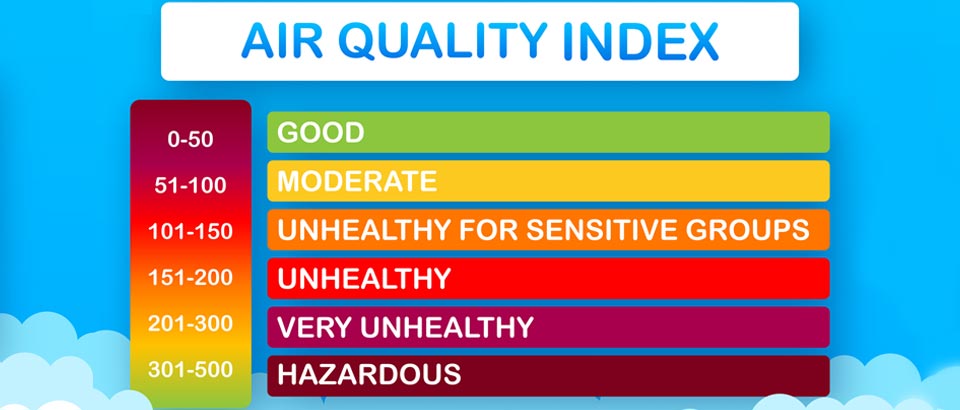August 9, 2024
While in general, our nation’s air quality has improved since the 1990s,1 many challenges remain when it comes to keeping people safe from the issues that arise from poor air quality.
Two of the most common issues are high levels of ground-level ozone and fine particulate matter. These are airborne soot, dust, dirt and smoke particles that come from vehicles, industrial factories and forest fires.2
We’re going to deep dive into this and help you become more aware of the pollution levels in the air, how they impact your health and what you can do to protect yourself when the Air Quality Index (AQI) is high.
What is the AQI?
The AQI forecast reports how clean or polluted the air in your town is at any given time. It is based on the amount of five major air pollutants in the air at the time of measurement. These five pollutants are ground-level ozone, particle pollution, carbon monoxide, sulfur dioxide and nitrogen dioxide.3
The AQI is based on a scale of zero to 500, with zero being completely clean air and 500 meaning the highest level of pollution possible. In 1980, when the AQI was first being measured, the national average was 59.6. This is in the average range. By 2020, the average fell to a good range of 36.4. That’s good news, as it shows some level of improvement.
However, different industrial and environmental factors, such as wildfires, can impact that AQI on a daily basis.
What does each color level of the AQI mean?

You’ll often see colors used to indicate AQI on a map. When taking a look, here’s what they mean:
- Green (0-50, good): This level means that there is little to no health risk involved because of the air quality.
- Yellow (51-100, moderate): The air quality is acceptable. However, children, older adults and outdoor workers as well as those with breathing issues, lung disease and asthma may experience some issues.
- Orange (101-150, unhealthy for sensitive groups): The air quality presents a health risk for children, older adults and those with heart disease and lung disease. They should limit the amount of time spent outside.
- Red (151-200, unhealthy): At this level, the air is considered unsafe to everyone. Those with health conditions should avoid outside activity, while everyone else should limit the time they spend outside.
- Purple (201-300, very unhealthy): This level is considered a serious health risk for everyone. Those with compromised health should avoid going outside.
- Maroon (300-500, hazardous): Everyone should avoid going outside as the air has become a serious health risk. In some instances, you may be asked to evacuate.
Who does AQI impact?
Air pollution is harmful for all of us, but it can be really dangerous for the following people:
- Children
- Teens
- Anyone over 65
- Those with the following health conditions:
- Asthma
- Post-COVID-19 respiratory issues
- Other lung diseases
- Diabetes
- Cardiovascular disease
- High blood pressure
- Stroke and heart attack survivors
How can you protect yourself if you have to go outside?
You’ve read the warnings and know the dangers, but if you still need to go outside or even work in the outdoors, you need to protect yourself. Here are some tips:
- Stay informed. If you need to be outside, check your local radio and TV weather reports as well as Airnow.gov for daily air pollution forecasts.
- Wear a face mask. If you are concerned about air quality or are near an alerted area, a face mask may help. Your mask must be rated as N95 and fit snugly over your nose and mouth. Surgical masks, medical masks, bandanas and face coverings aren’t designed to filter out harmful air pollutants.
- Avoid congestion. Because vehicle exhausts contains particle pollution, try to avoid any activity near high areas of traffic.
- Stick to the morning. Ozone pollution can be worse on hot sunny days and ozone levels tend to accumulate during the daylight hours. Particulate matter concentrations are also higher as the day goes on. Plan any outdoor activities in the morning, as air quality may be worse in the afternoon and early evening.
- Take it easy. You breathe harder when you do more intense activities or are active for a long period of time. The harder you breathe; the more pollution enters your lungs. To prevent this, take breaks more often or try walking instead of running (at least until the AQI gets better).
How can I protect myself indoors?

You can also take steps to protect yourself when you’re inside your home by keeping the doors and windows shut to prevent any polluted air from getting in. Having an HEPA-approved air purifier can also help.
When it gets hot, it’s generally safe to use air conditioning. Make sure that your AC is set to recirculating air mode so you don’t pull in air filled with fine particles from the outside. Ensure that any bathroom fans or vent hoods also aren’t bringing in outside air.
When should you seek medical attention?
If you experience any of the following symptoms, you should seek medical attention immediately:5
- Chest tightness or pain
- Coughing (except for a light, dry cough)
- Difficulty breathing
- Dizziness
- Headaches
- Painful eye irritation
- Sore throat
- Wheezing
Keep in mind that if you have a light cough, a slight throat irritation or itchy eyes, that’s not reason enough to believe that air quality is impacting your health.
How does air quality impact existing health conditions?
While air quality impacts even healthy people, if you’re managing an existing health condition, you need to be even more aware of each day’s AQI.
Heart disease: Those dealing with heart disease should be extremely cautious, as the fine particulate matter that comes with higher AQI may impair blood vessel function and speed up calcification in arteries.5
Additionally, breathing in particle pollution can often cause symptoms that feel like a heart attack. Those symptoms include:6
- Chest pain or tightness
- Exhaustion or feeling more tired than normal
- Fast or irregular heartbeat
- Feeling winded or out of breath
If you are experiencing any of these symptoms, seek medical help or call your provider immediately. You should also inform them if your symptoms are lasting longer or are more severe than normal.
Asthma: Particle pollution may increase the severity of your symptoms. If you have an asthma management plan, follow it carefully on days where the AQI is here. If you don’t have one, consider this the perfect time to create one.
Chronic obstructive pulmonary disease (COPD) and other lung issues: Studies have shown that a higher AQI was linked to worse day-to-day symptoms for those with COPD. Exposure to polluted air may also lead to the development of COPD.7
Pregnancy: Studies have shown that exposure to airborne pollution may lead to low birth weight, premature birth and smaller birth weight.8 Expectant mothers should take precautions when going outside on days with high AQI numbers and discuss any concerns with their provider.
By keeping track of the AQI and following these tips, you can stay healthy during bad air quality days. If you are experiencing any symptoms or discomfort, our medical team is available to get you back to feeling better. Our neighborhood medical centers are open from 8 to 8, seven days a week.
Originally published August 2023. Updated August 2024.
References:
1 Environmental Protection Agency. Annual Summary Data. Accessed June 28, 2023.
2 National Weather Service. Clearing the Air on Weather and Air Quality. Accessed June 28, 2023.
3 American Lung Association. Air Quality Index. Last updated November 17, 2022. Accessed June 28, 2023.
4 Air Now. Air Quality and Outdoor Activity Guidance for Schools. Accessed June 28, 2023.
5 CDC. About Air Quality. Last updated May 14, 2024. Accessed August 9, 2024.
6 National Institute for Health and Human Services. Air Pollution and Your Health. Last updated March 23, 2023. Accessed June 29, 2023.
7 Science Direct. Personal and community-level exposure to air pollution and daily changes in respiratory symptoms and oxygen saturation among adults with COPD. Last updated June 15, 2023. Accessed June 29, 2023.
8 World Health Organization. Air quality and health. Accessed June 29, 2023.
